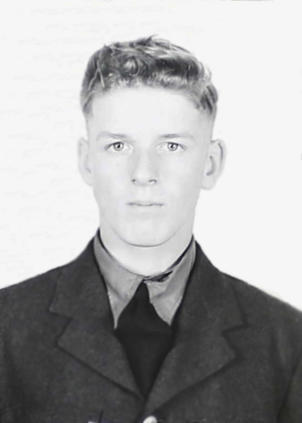
copyright © Wartime Heritage Association
Website hosting courtesy of Register.com - a web.com company
Wartime Heritage
ASSOCIATION
Remembering World War II

Name:
Rank:
Service No:
Service:
Date of Birth:
Place of Birth:
Date of Enlistment:
Place of Enlistment:
Age at Enlistment:
Height:
Complexion:
Eye Colour:
Hair Colour:
Trade:
Marital Status:
Religion:
Next of Kin:
Date of Death:
Age at Death:
Cemetery:
Reference:
Frederick William Hood
Frederick William Hood
Pilot Officer
J/88657
57 RAF Squadron, Royal Canadian Air Force
April 28, 1923
Ottawa, Ontario
May 27, 1942
Halifax, NS
19
5 feet, 5 inches
fair
blue
brown
Clerk (National Fish Company Ltd., Halifax)
Single
Church of England
Thomas Hood (Father) Halifax, NS
July 5, 1944
21
Aubermesnil Churchyard, Seine-Maritime, France
Collective Grave
Commemorated on page 338 of the Second World War Book of Remembrance
Displayed in the Memorial Chamber of the Peace Tower in Ottawa on July 21
Pilot Officer Hood was the son of Commander Thomas Hood, Royal Canadian Navy Volunteer
Reserve, and Mabel Wallace Hood, of Bear River, Annapolis Co., NS. He was the brother of Thomas
Ronald Hood, Henry Alexander Hood, Patricia (Hood) Hewitt, and Ruth (Hood) MacDonald. Frederick
was born in Ontario where he lived until the age of two and eighteen years in Nova Scotia. At the time
of his enlistment the family resided in Halifax.
Frederick completed grade 10 and one year of Diesel engineering at Nova Scotia Tech. His hobby
was boat model building.
Following his training in Canada he went overseas in May, 1943 and was initially assigned to RAF
Trainees Pool. He joined 57 RAF Squadron on April 30, 1944.
Lancaster aircraft JB.723 of 57 Squadron took off from RAF East Kirkby, Lincolnshire at 23.22
hours on July 4, 1944 to attack St. Leu D’Esserent in northern France. The aircraft failed to return
from the operation. Pilot Officer Hood was the Navigator on the flight.
In 1946 it was confirmed that the aircraft crashed in flames with no survivors. The remains of the
crew were buried in two coffins by the Germans immediately after the crash and the following day.
Individual identification was not possible.





- World War I - Menu
- WWI Stories and Articles
- Photos - Yarmouth Soldiers
- Selection of World War I Songs
- WWI Casualties of Yarmouth, NS
- Those Who Served - Yarmouth, NS
- WWI Casualties Digby Co. NS
- WWI Casualties Shelburne Co. NS
- Merchant Mariners (1915) Yarmouth, NS
- Canadian Forestry Corps - Non Yarmouth Birth/Residence Enlistments
- US Draft Registry - Yarmouth NS Born


- World War II - Menu
- WWII Stories and Articles
- Telegraphist Air Gunners
- WWII Casualties of Nova Scotia
- US Casualties with NS Connection
- Far East/Pacific Casualties with NS Connection
- Merchant Navy Casualties Nova Scotia
- Nova Scotia WWII Casualties Holten Canadian War Cemetery
- D-Day Casualties - Nova Scotia
- CANLOAN Program Casualties - Nova Scotia
- Battle of the Bulge Casualties - Nova Scotia
- WWII Casualties Yarmouth NS
- Yarmouth Casualties - RCAF RAF Canadian Army WWII
- Yarmouth Co., Marriages WWII
- Casualties Non-Born/Residents with Connection to Yarmouth Co., Nova Scotia.
- WWII Casualties Digby Co., NS
- Non-Nova Scotian WWII Casualties Buried in Nova Scotia
- WWII RCAF Casualties Aged 16-18
- Brothers/Sisters Who Served - World War II














